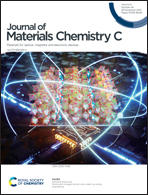Solvent/UV driven information encryption based on a multilayer quasi-amorphous photonic heterostructure†
Abstract
Herein, we demonstrate an information encryption strategy based on multilayer quasi-amorphous photonic structures (QAPS) composed of alternating arrangements of high and low refractive index materials. The designs are created by alternately spraying monodisperse SiO2 and Fe3O4@SiO2 colloidal particles as well as CdSe/ZnS quantum dots (QDs) on a specific substrate, which can realize solvent/ultraviolet (UV) driven multiple information encryption and decryption. Due to the strong light scattering of the top SiO2 QAPS layer, the information stored in the lower Fe3O4@SiO2 layer is encrypted. After infiltration of the ethanol solvent into the voids of QAPS, the SiO2 layer becomes transparent due to the vanishing of refractive index contrast between SiO2 and ethanol, while the Fe3O4@SiO2 layer maintains bright structural color due to its high refractive index. At the same time, the information carried by QDs can be revealed under the excitation of UV light. Thus, this simple and reliable information hiding/displaying system, together with diverse encryption modes and convenient manufacturing process, makes it a potential security material to be applied in various fields.



 Please wait while we load your content...
Please wait while we load your content...